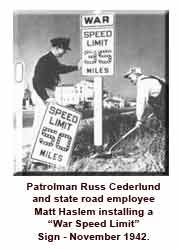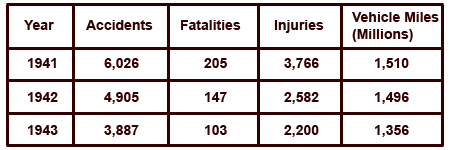War Speed Limit
On October 28, 1942, a War Speed Limit of 35 mph came into affect in an attempt to conserve gasoline and save on tires. Enforcement began on November 10, 1942. Many cars were operating with unsafe tires because people were unable to buy new tires. This new speed regulation was adopted as the result of a report made following an engineering study of the tires on vehicles, conducted by the National Safety Council with the cooperation of the Utah Highway Patrol, at the request of the Utah Highway Traffic Advisory Committee to the War Department. This report contained the following comments:
 “46 percent of cars driven by war workers had at least one tire with the tread worn smooth, 23 percent with at least two tires worn smooth and 11 percent with at least three.”
“46 percent of cars driven by war workers had at least one tire with the tread worn smooth, 23 percent with at least two tires worn smooth and 11 percent with at least three.”
“The study indicates at least 40 percent of all the cars using the streets and highways of Utah have at least one smooth tire, 21 percent have two or more, and nine percent have at least three. At least three percent of the tires on these cars were worn so badly that fabric was showing or large breaks existed in the carcass.”
This law was later called the “patriotic speed limit’ in an attempt to gain compliance. From the beginning the UHP experienced difficulty in enforcing this restrictive speed. The hard work and combined efforts of the Patrol during this era, would be recognized at the end of the war by large budget cuts. This would not be the first time the image of the Patrol would suffer due to enforcement of an unpopular law.
With the implementation of the War Speed Limit of 35 mph, Patrolman Russ Cederlund was featured on the cover of the November 1942 issue of Public Safety, a national magazine devoted to promoting public safety. Patrolman Cederlund and Matt Haslam of the state road shop are shown replacing a 50 mph sign with a 35 mph sign. Because all of Utah’s 40, 50 and 60 mph signs were reflectorized, all of these signs had to be replaced. The old signs were stored in anticipation that the speed limit would be raised following the war.
Despite a 5 percent increase in motor vehicles in Utah from 1941 to 1943, Utah had a significant decrease in accidents, injuries, and fatalities. The following chart represents this decrease:
Although vehicle miles traveled decreased 11 percent, fatal accidents in Utah decreased by 50 percent, the ninth lowest in the United States. Utah was the only state in the nation with an increase in motor vehicle registrations during this period of time. The only area of the state which showed an increase in fatal accidents was Utah County. Colonel Pete Dow immediately transferred two patrolmen from the southern district to assist the Utah County personnel in slowing down the many “chronic speeders” in Utah County.
During World War II, the Utah Highway Patrol established a safety inspection station at the Salt Lake District office located at 1225 North Beck Street. Inspections were performed at this location free of charge. Equipment was installed to check wheel alignment, brake efficiency, correct lighting, and other mechanical functions.
Approximately 90 percent of the automobiles tested failed to meet established standards. Motorists were given a list of the defects on their car. Patrolman Cederlund was in charge of this equipment. He told the Salt Lake Telegram, “We’re not trying to make wholesale arrests or anything like that. Each motorist owes it to himself and to his county – as well as to his fellow motorist – to see that his car is in perfect running order.” Later, the North Beck Street station included scales for weighing trucks.
By 1944, patrolmen were experiencing numerous problems with stickers on vehicle windshields. The law required a state safety inspection sticker, a federal automobile tax stamp, a gas ration sticker (s) (only the highest value should be displayed), and Army and Navy war industry entrance stickers (which were supposed to be displayed on the side wing windows). State inspection stickers were called “V-40” stickers. In 1942, every vehicle in Utah was required by law to be inspected at the same time, from June 1st to July 15th. By 1946, this inspection period was extended from May 15th to August 15th. Educating the motoring public as to which stickers were to be placed where was a never ending task.
In April 1944, the National Safety Council awarded Utah the Grand Award for 1943. A letter from Governor Herbert B. Maw to Colonel P. L. Dow stated, “Without question, this high honor has come to our State largely because of the efficient work performed by the members of the State Highway Patrol…”
The Patrol had proven that accident reduction is a direct result of aggressive enforcement. Following World War II, the legislature proved that budget cuts are often another direct result of aggressive enforcement.

